Wicked Priest (Gokuaku Bozu)
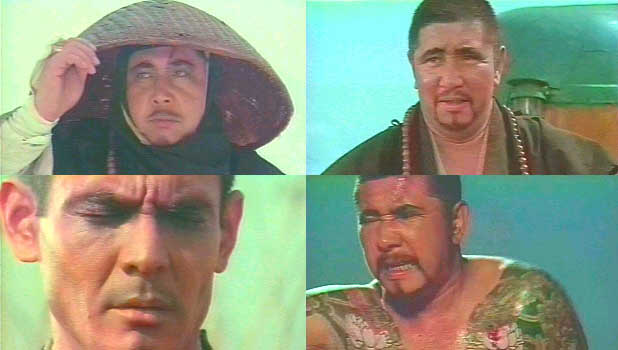
A few years before he was to begin the “Lone Wolf and Cub” series of
films, Tomisaburo Wakayama had already been involved in some other series
– this being one. At the same time as “Wicked Priest” was being made (1968
to 1971), he was also making two other series of films – “Gokudo” (1969 to
1974) which was a series of 11 films about the life of Yakuzas and “Red Peony:
Lady Gambler” (1968 to 1972) which was about a female gambler starring Junko
Fuji with Tomisaburo showing up in most of the 8 episodes. Definitely a busy
man! But he had to be in order to try and keep up with his half brother Shintaro
Katsu who was making the outpouring of Zatoichi films as well as many other
films. In “Wicked Priest” Tomisaburo often has a strong resemblance to Shintaro
from certain angles – especially in one episode in which he is blinded! There
are more than a few nods to Zatoichi in the series.
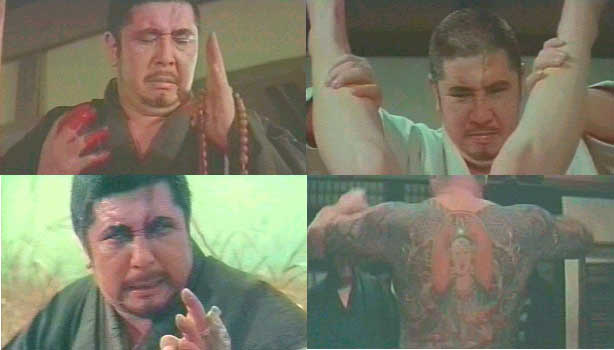
I am not clear on how many films in this series there are. "Japanese Cinema"
by Thomas Weisser lists four, but there may be two others as well. Of the
three films in the series that I have found, one is clearly not among the
films that Weisser lists and I found reference to another film – “Cast a
Wicked Net” (1970) that doesn’t appear to be any of the five films I know
of. As far as I can tell neither of the first two films in the series are
available so the ones reviewed here may be episodes 3,4 and 5 or possibly
3, 4 and 6 – if anyone is an expert on the series please fill me in. The
series takes place in the Meiji period (1868-1912) – probably near the end
of the century as guns seem to be becoming prevalent.
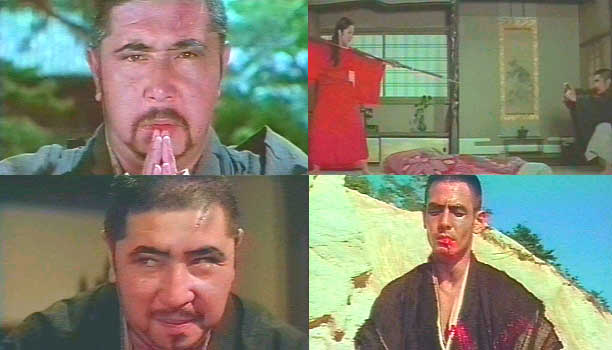
The Wicked Priest is an interesting character – clearly influenced by the
wandering tales of Zatoichi, but the Buddhist priest is a much more shaded
hero who has a strong sense of justice but also a great enjoyment in the
vices of women, gambling and drinking - a moral issue that he has trouble
reconciling. He is a strong burly man with a gashing scar that travels from
his hairline down to his left eye, dressed in a simple cassock with a straw
basket hat to protect him from the sun (and the occasional sword!), prayer
beads around his neck and a staff always at the ready – that contains a sword
of course. Beneath his garments, his body is designed by an intricate pattern
of tattoos that cover his chest and back. He is generally an amiable person
with a lecherous eye until he comes across some injustice at which point
he turns into a thundering coil of anger. He narrates, “Let all evils fall
on me. I live for the challenge of conquering them.”

Each of the three films I saw had certain similarities – like Zatoichi the
beginning of each episode finds Shinkai (the Wicked Priest) in a different
town where trouble soon finds him. He comes across situations where the powerful
are taking advantage of the weak and does what he can to fix this – eventually
at the point of his deadly sword. There is usually a woman in there as well
that he can’t resist and who can’t resist him. As well as being a terrific
swordsman, he is apparently quite the cocksman as well and few women can
resist him – and once they succumb they become addicted! In each episode
his nemesis Ryutatsu the Whipmaster (Bunta Sugawara) shows up to challenge
Shinkai in a duel to the death – which obviously never is concluded. Ryutatsu
has a deep abiding hatred for the Wicked Priest and though blind he manages
to follow him all around the country and show up at the most inopportune
times. Played by Bunta, he is an imposing figure – tall, thin and like a
grim reaper with his whip always at the ready. The films tend to be comparable
to the Zatoichi films in terms of graphic violence for the most part –
the two-fingered thrust being particularly gory – but there is nothing here
to compare to the crazy over the top violence of the “Lone Wolf” series. There
are usually about three to four action scenes – one that always begins the
film and one that always ends the film – but there is a lot of plot and character
development in between.

According to Weisser, in the first episode Shinkai and Ryutatsu are both
Buddhist priests who duel and it was at this time that Ryutatsu became blinded
by a two-finger thrust on the part of Shinkai. In episode two, Ryutatsu recovers
and is converted into Christianity and makes it his life's work to track
down Shinkai and kill him. I am not entirely sure as to the accuracy of this
as Weisser makes errors in his summaries of episodes 3 and 4, which he would
not have made had he seen the films!
Wicked Priest: Pilgrimage of Death (Gokuaku Bozu:
Nembutsu Hitokiri-Tabi)
Director: Harada Takashi
Year: 1969
Production Company: Toei
Running Time: 1 hour 32 minutes
It must be the prayer beads. Shinkai is walking through a small town
when a gentleman invites him home to have dinner and deflower his daughter.
It is the custom of this town that before marrying, a woman has to lose her
virginity to a stranger – now if I could just find this place! No one is
stranger than I am. After doing his priestly duty, he runs off quickly before
the daughter asks for seconds. He next finds himself in a rural village that
is nearly all female as the men are away fishing for the next few months
and he happily looks forward to having some fun. A woman named Onine invites
him to her house, but she soon discovers that Shinkai killed her husband
three years before and asks him to leave before the dead man’s brother returns.
He has been looking for Shinkai all these years to revenge his brother.

Before Shinkai can leave or satisfy his lust, the town is taken over by a
group of rebels who are planning a conspiracy against the government and
are waiting for an arm’s shipment. They begin mistreating the villagers and
Shinkai feels obliged to help them out. The brother returns, but after first
dueling Shinkai, the two of them band together to fight the gang. There is
also a religious fraud that Shinkai blinds with his patented two-finger jab
deep into the eyeballs and afterwards he tells the fellow “now you can be
a blind masseuse and go from town to town”. In the end Shinkai removes his
shirt to reveal his tattoos and takes on the entire gang single handily.
Ryutatsu shows up near the end and they duel for a bit before Shinkai has
to break off to save the village.

Wicked Priest: Comes Back (Gokuaku Bozu: Nembutsu
Sandan Giri)
Director: Harada Takashi
Year: 1970
Production Company: Toei
Running Time: 1 hour 34 minutes
Shinkai runs into his childhood friend,
Takagano (Ichiro Nakatani), in a gambling hall where he has been trying to
cheat the house. They catch Takagano and he is forced to remove a finger
– which he chooses to do with his weapon of choice – a shotgun. When they
were young boys they both left their small village of Nogata and went to
make their way in the world – Shinkai to hopefully become a famous Buddhist
priest and Takagano to become wealthy – neither succeeded as one is a poor
wandering priest and the other a lowly Yakuza. Shinkai is returning home for
the first time since he left all those years ago to pray at his mother’s grave.
Before getting there though he is waylaid by a “nun” who invites him in from
the cold, “accidentally” leaves her bedroom door open to entice Shinkai and
then tries to rob and kill him! He is able to turn the tables even though
she has a deadly crotch grip.

Once he arrives at his village he soon discovers that not all is well. Two
gangs who want to control the river workers – the main employment of the
town – are competing for power and exploiting the workers. At the same time
some men with a grudge track Shinkai down and hire Takagano to kill him.
If that’s not enough, Ryutatsu shows up once again. Shinkai sides with his
old town against both gangs, but an explosion blinds him and he has to wander
off like a wounded animal to heal. He is saved by the "nun" Hakuyo who nurses
him back and also teaches him to fight without seeing. He then does a Zatoichi
and takes on the gangs. Ryutatsu realizes his condition and decides that
instead of killing Shinkai in his present condition, he will assist him –
and only fight him when he has recovered. At the end though when he sees
Shinkai praying at his mother’s grave, he turns away and leaves – a moving
scene. This character was later to get his own film called “Blessed Virgin
Killer” in 1974.
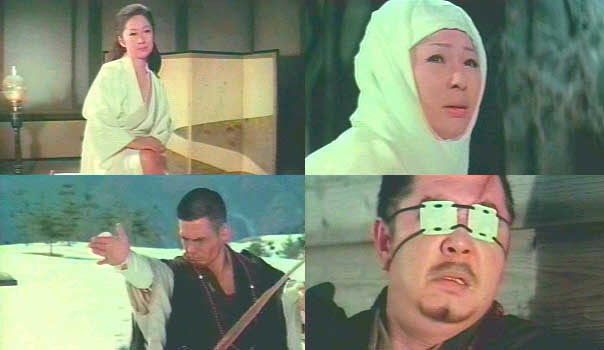
Wicked Priest: Breaking the Commandments (Gokuaku
Bozu: Nomu Utsu Kau)
A.K.A.- Drinking, Gambling and Women
Director: Saito Buichi
Year: 1971
Production Company: Toei
Running Time: 1 hour 29 minutes
It’s not easy working your way through an entire brothel but Shinkai
is doing a good job of it when a gang looking for someone interrupts him.
Not taking kindly to this, he gets into a fight with them while dressed only
in his loincloth and has to escape in such when the police show up. He finds
shelter at an old mansion that has become home to many poor people. After
retrieving his clothes and staff, he gets into a dice game with a female
gambler, Ogin, who tries to cheat him – when she is unsuccessful the price
she has to pay is her body – but after a night of revelry and joy she still
steals all his money and escapes. Shinkai becomes friends with Wajima, the
head of a transportation service, and when someone tries to muscle him aside
with the assistance of the head of the police and tries to remove the folks
from the mansion to build a wharf it is time for Shinkai to bring his staff
to bear.

The bad guys hire three assassins to kill Shinkai – one a beautiful female
who tries to seduce him with the end of a sharp blade – but he quickly disposes
of them. Later he runs into Ogin again – now the mistress of the head of
police – but one more session with Shinkai and she is ready to assist him
in his plan to help Wajima. In the end of course he has to take on the gang
by himself and he cuts a swathe of blood looking for justice. Smelling the
blood on Shinkai, Ryutatsu tracks him down and the film ends with a fight
that leaves both men near death.

All of these films are quite enjoyable if not up to the levels of either
Zatoichi or Lone Wolf in either production values or entertainment value.
They were produced by Toei, but apparently never quite caught on with the
public.
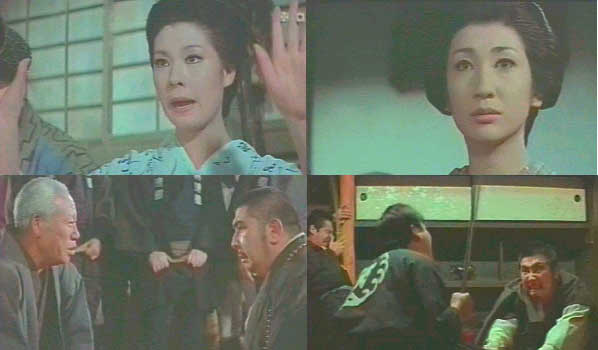
My rating for the films: 7.0












